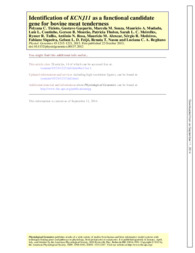Identification of KCNJ11 as a functional candidate gene for bovine meat tenderness.
Identification of KCNJ11 as a functional candidate gene for bovine meat tenderness.
Author(s): TIZIOTO, P.; GASPARINI, G.; SOUZA, M. M.; MUDADU, M. de A.; COUTINHO, L. L.; MOURÃO, G. B.; THOLON, P.; MEIRELLES, S. L. C.; TULLIO, R. R.; ROSA, A. do N.; ALENCAR, M. M. de; MEDEIROS, S. R.; SIQUEIRA, F.; FEIJO, G. L. D.; NASSU, R. T.; REGITANO, L. C. de A.
Summary: The potassium inwardly rectifying channel, subfamily J, member 11 (KCNJ11) gene was investigated as a candidate for meat tenderness based on the effects reported on muscle for KCNJ11 gene knockout in rat models and its position in a quantitative trait locus (QTL) for meat tenderness in the bovine genome. Sequence variations in the KCNJ11 gene were described by sequencing six amplified fragments, covering almost the entire gene. We identified single nucleotide polymorphisms (SNP) and validated them by different approaches, taking advantage of simultaneous projects that are being developed with the same Nelore population. By sequencing the KCNJ11 in Nelore steers representing extreme phenotypes for Warner-Bratzler shear force (WBSF), it was possible to identify 22 SNPs. We validated two of the identified markers by genotyping the whole population (n = 460). Analysis of association between genotypes and WBSF values revealed a significant additive effect of a SNP at different meat aging times (P ? 0.05). In addition, an association between the expression levels of KCNJ11 and WBSF was found, with lower expression levels of KCNJ11 associated with more tender meat (P ? 0.05). The results showed that the KCNJ11 gene is a candidate mapped to a QTL for meat tenderness previously identified on BTA15 and may be useful to identify animals with genetic potential to produce tender meat. The effect of KCNJ11 observed on muscle is potentially due to changes in activity of KATP channels, which in turn influence the flow of potassium in the intracellular space, allowing establishment of the membrane potential necessary for muscle contraction.
Publication year: 2013
Types of publication: Journal article
Keywords: Bovine, Candidate gene, Differential expression, Molecular markers, Shear force, Warner Bratzler, beef, meat
Observation
Some of Embrapa's publications are published as ePub files. To read them, use or download one of the following free software options to your computer or mobile device. Android: Google Play Books; IOS: iBooks; Windows and Linux: Calibre.
Access other publications
Access the Agricultural Research Database (BDPA) to consult Embrapa's full library collection and records.
Visit Embrapa Bookstore to purchase books and other publications sold by Embrapa.

